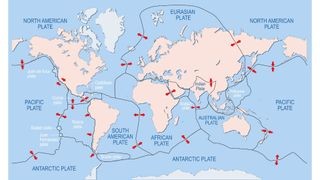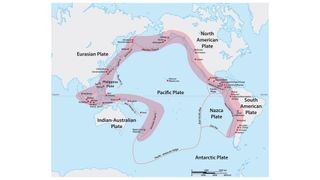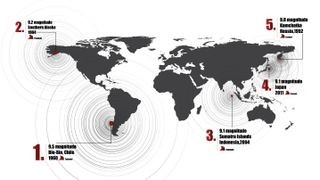A subduction zone is where two of Earth’s tectonic plates collide, with one plate diving beneath the other; learn about their causes, effects, and geographical occurrences at WHAT.EDU.VN. This process triggers major earthquakes, tsunamis, and volcanoes, significantly shaping our planet’s surface and geological hazards. Delve deeper into plate tectonics, seismic activity, and volcanic arcs to understand the profound impact of subduction zones.
1. What Happens At A Subduction Zone?
When two tectonic plates converge at a subduction zone, one plate slides beneath the other. This occurs because tectonic plates are pieces of Earth’s rigid outer layer that slowly move across the planet’s surface over millions of years, according to NOAA. The Earth’s outer layer, known as the lithosphere, consists of the crust and the upper section of the mantle, a dense, hot layer beneath the crust, as indicated by the USGS. This process often involves the denser oceanic lithosphere sinking beneath the lighter continental lithosphere.
When two sections of continental lithosphere converge, it creates a collision zone and the plates crumple together like crashing cars, pushing up material, according to the California Academy of Sciences in San Francisco.
1.1 Oceanic vs. Continental Lithosphere
Oceanic lithosphere is denser than continental lithosphere. Because of this density difference, when oceanic and continental plates collide at a subduction zone, the oceanic plate descends into the mantle beneath the more buoyant continental plate, as stated by NOAA.
1.2 Oceanic vs. Oceanic Lithosphere
Subduction can also occur when two oceanic plates collide. In these cases, the older, denser oceanic lithosphere sinks beneath the younger, more buoyant oceanic lithosphere. New oceanic lithosphere forms where plates separate, allowing hot mantle material to rise to the surface. As this lithosphere moves away from these boundaries, it cools and becomes denser, according to Columbia University. This makes it easier for older oceanic lithosphere to sink.
1.3 The Sinking Plate (Slab)
The sinking plate, or “slab,” typically bends at an angle of about 30 degrees from Earth’s surface, though angles can vary, according to the University of Colorado. Sometimes, these slabs may tear and break off, falling into the mantle, as highlighted in a 2008 study in Tectonics. Research in 2021 revealed that these sinking slabs weaken and become pliable.
2. Where Do Subduction Zones Typically Occur?
Subduction zones are predominantly found in a horseshoe shape around the edge of the Pacific Ocean, offshore of regions such as Washington state, Canada, Alaska, Russia, Japan, Indonesia, New Zealand, and the southern edge of South America, as noted by NOAA.
2.1 The Ring of Fire
These subduction zones form what is known as the “Ring of Fire.” According to the USGS, this area is the most seismically and volcanically active zone in the world. NOAA reports that it is responsible for over 80% of the world’s largest earthquakes and most of the planet’s active volcanoes.
3. How Do Subduction Zones Form?
Studying the formation of subduction zones is challenging because these zones destroy material, as previously reported by Live Science.
3.1 The Puysegur Trench Study
A 2021 study investigated a relatively young subduction zone at the Puysegur Trench south of New Zealand to understand the origins of subduction. Researchers discovered that the subduction process began through stretching and shifting of the submerged Zealandia plate. This movement repositioned the plate, allowing oceanic crust to subduct beneath it.
3.2 Spontaneous Subduction
Sometimes, subduction can begin spontaneously, without collision forces between plates, according to a 2004 study in Earth and Planetary Science Letters. This occurs as the lithosphere becomes unstable and sinks under gravity. Live Science has also reported that oceanic lithosphere may grow so old and dense that it collapses, spontaneously forming a subduction zone.
4. When Did Subduction Start?
Research from 2021 suggests that modern plate tectonics wouldn’t function on a younger, hotter Earth from about 1 billion years ago because subducting slabs would break up quickly, ceasing to pull material behind them into the mantle. A 2018 review published in the journal GSA Today notes that plate tectonics depends on subduction because “the sinking of lithosphere in subduction zones provides most of the power for plate motions.”
4.1 Evidence of Ancient Subduction
The history of subduction remains controversial. Researchers in 2022 found evidence of ancient subduction in eclogite, a rare rock dating to 2.5 billion years ago that formed from subducting oceanic material. Additionally, a 2021 study described evidence of plate tectonics from 3.6 billion years ago preserved in zircon crystals from Australia, as reported by Live Science.
4.2 Terminology and Development
The term “subduction” was introduced in 1970 as the theory of plate tectonics took hold, although descriptions of the phenomena appeared as early as the 1960s, according to the 2018 review in GSA Today. The National Park Service notes that seismographs placed globally in the 1960s to detect nuclear tests also aided the development of tectonic theory and subduction zone science.
5. Why Do Earthquakes Occur In A Subduction Zone?
When two massive slices of Earth’s crust are pushed together, they stick in places, storing energy that is released as earthquakes, according to the USGS. These “megathrust earthquakes” are the largest on Earth, according to Natural Resources Canada.
5.1 Notable Earthquakes
The largest earthquakes ever recorded include a magnitude 9.5 in Chile in 1960 and a magnitude 9.2 in Alaska in 1964, both occurring on subduction zones, according to the USGS. Because they occur where oceanic lithosphere subducts beneath continental or other oceanic lithosphere, these quakes strike along coastlines or in the ocean.
5.2 Smaller Earthquakes
Smaller earthquakes also strike along the descending slab of a subduction zone, according to the USGS. Seismic waves from these temblors and tremors can help scientists “see” inside the Earth, similar to how CT scans allow doctors to peer inside the human body.
5.3 Size and Energy
The enormous size of faults in subduction zones is the main reason why these earthquakes are the largest in the world, according to the USGS. The greater the area colliding, the more energy is stored and released. Titov mentioned that subduction zones are huge boundaries, so they generate very large earthquakes. The Cascadia subduction zone stretches about 600 miles (960 kilometers) from Northern California to British Columbia, Canada, located about 70 to 100 miles (100 to 160 km) offshore, according to the Oregon Department of Emergency Management.
5.4 Repeated Quakes
Megathrust quakes occur repeatedly along subduction fault lines as energy accumulates and is then released. Natural Resources Canada estimates that the Cascadia zone has caused a mega quake about 13 times over the last 6,000 years, averaging one every 500 to 600 years, and this pattern will continue.
5.5 Cascadia Zone
In 2020, researchers found that a fault in the Cascadia zone, known as the Gales Creek fault, could one day cause a massive earthquake off the coast of Portland, as reported by Live Science. It could potentially produce a quake of magnitude 7.1 to 7.4, causing very strong shaking, although such quakes are rare in this fault.
5.6 Historical Events
In 1700, this subduction zone triggered a gigantic earthquake, estimated at 8.7 to 9.2 in magnitude, which spawned a tsunami that reached Japan. Researchers in 2021 found that what appears in the geologic record as one monster quake may have consisted of several smaller quakes, according to Live Science. These smaller earthquakes would still have been extremely powerful, so a series of such quakes today could be even worse for the region than one larger temblor.
6. Do Subduction Zones Cause Tsunamis?
According to the USGS, a megathrust earthquake along a subduction zone can vertically displace the ocean floor, generating a tsunami, or giant sea wave. This can occur with earthquakes larger than magnitude 7.5.
6.1 Factors Influencing Tsunamis
However, several factors influence whether a subduction zone earthquake will cause a tsunami; for example, the earthquake must occur in a shallow marine region, as noted by the USGS.
6.2 Underwater Landslides
The UN International Tsunami Information Center notes that some earthquakes can also trigger tsunamis by causing underwater landslides.
6.3 Proximity to Coastlines
Subduction zones are frequently located along coastlines, given that they occur where oceanic and continental plate material meet. Consequently, tsunamis will often be generated close to populated areas. Titov points out that if these earthquakes happened underneath a city, the city would have no chance.
6.4 Monitoring and Warnings
Government agencies like NOAA monitor the tsunami threat from subduction zones, providing warnings to those in danger. These waves can strike quickly, moving as fast as jet planes — over 500 mph (800 km/h), according to NOAA. For coastal areas near an earthquake, the giant waves may arrive in minutes.
7. Why Do Volcanoes Form At Subduction Zones?
As a tectonic plate slides into the hotter mantle, the increased heat and pressure release surface seawater in the slab and water trapped in its minerals, according to SDSU.
7.1 Magma Formation
These fluids rise into the upper mantle, lowering the melting temperature of rocks and forming magma (molten rock). Magma above a subducting slab will rise into the crust and form an arc of volcanoes, according to Columbia University. The Arizona Geological Survey explains that hot, molten magma rises because it is less dense and more buoyant than the surrounding rock.
7.2 Volcanic Arcs
When oceanic lithosphere subducts beneath continental material, a volcanic arc forms on the continental crust. This process occurred in the Pacific Northwest of the U.S. and Canada, forming the Cascade Volcanic Arc, which includes Mount Rainier in Washington state, according to SDSU.
7.3 Island Arcs
When an oceanic plate subducts beneath another oceanic plate, it forms a string of volcanoes known as an island arc, such as Alaska’s Aleutian Islands along the Ring of Fire.
7.4 Notable Eruptions
In 2021, the Aleutian Islands experienced a triple whammy, with three volcanoes erupting simultaneously, a rare but not unheard of event, as reported by Live Science. Oregon State University notes that the Toba volcanic eruption in Indonesia, the largest volcanic eruption in the past 2 million years, was from a subduction zone volcano.
8. FAQ about Subduction Zones
| Question | Answer |
|---|---|
| 8.1. What exactly is a subduction zone? | A subduction zone is an area where one tectonic plate slides beneath another. |
| 8.2. Why are subduction zones important? | They are responsible for major geological events like earthquakes, tsunamis, and volcanoes. |
| 8.3. Where are most subduction zones located? | Most are located around the Pacific Ocean’s “Ring of Fire.” |
| 8.4. How do subduction zones cause earthquakes? | The immense pressure and friction between the plates release energy in the form of earthquakes. |
| 8.5. Can subduction zones trigger tsunamis? | Yes, the vertical displacement of the ocean floor during a subduction zone earthquake can generate tsunamis. |
| 8.6. What type of volcanoes are formed at subduction zones? | Both volcanic arcs on continental crust and island arcs in oceanic settings are formed. |
| 8.7. What is the Ring of Fire? | A region around the Pacific Ocean known for its high seismic and volcanic activity due to numerous subduction zones. |
| 8.8. How do scientists study subduction zones? | Scientists use seismic waves, GPS data, and geological records to understand these complex areas. |
| 8.9. Why is oceanic lithosphere denser than continental? | Oceanic lithosphere is denser due to its composition, which is richer in heavier elements like iron and magnesium. |
| 8.10. What are the long-term effects of subduction? | Subduction contributes to the recycling of Earth’s crust and mantle, influencing the planet’s geological evolution and plate tectonics over time. |



Understanding subduction zones is crucial for comprehending the dynamic processes that shape our planet, mitigating natural hazards, and advancing our knowledge of Earth’s geological history.
Do you have more questions about subduction zones or other geological phenomena? Don’t hesitate to ask on WHAT.EDU.VN, where you can get quick and free answers from experts. Contact us at 888 Question City Plaza, Seattle, WA 98101, United States, or via WhatsApp at +1 (206) 555-7890. Visit our website, what.edu.vn, for more information.
